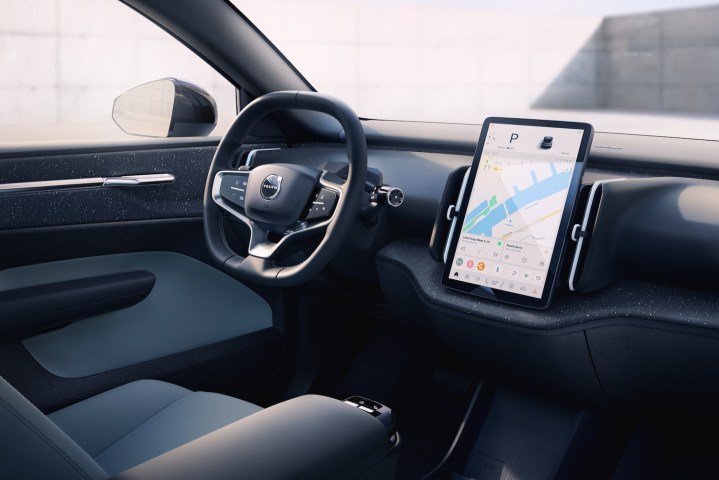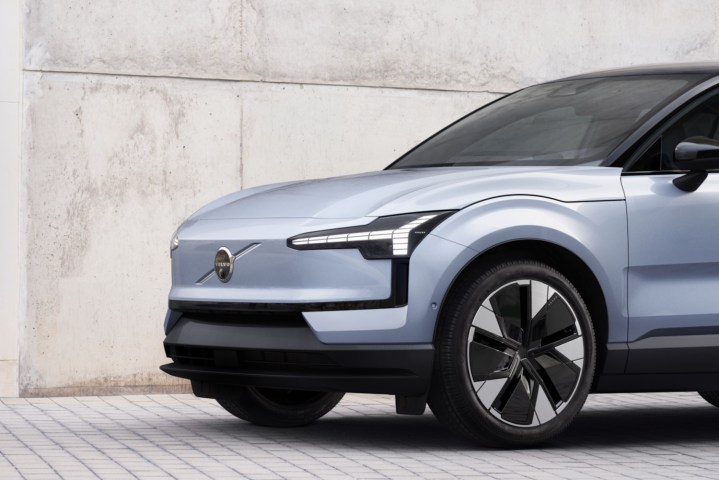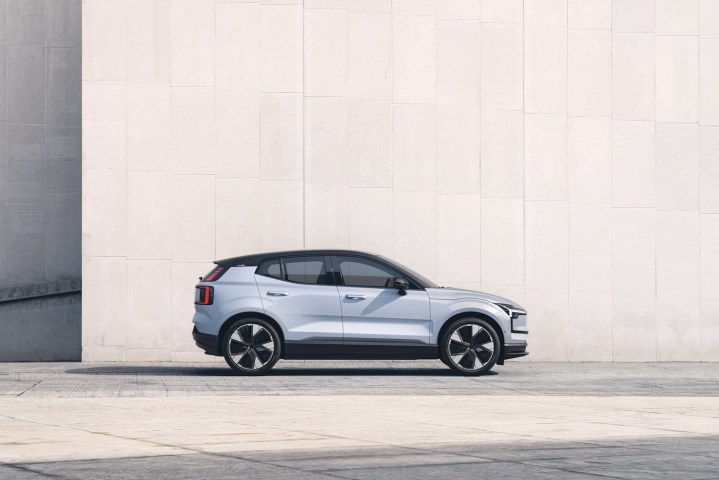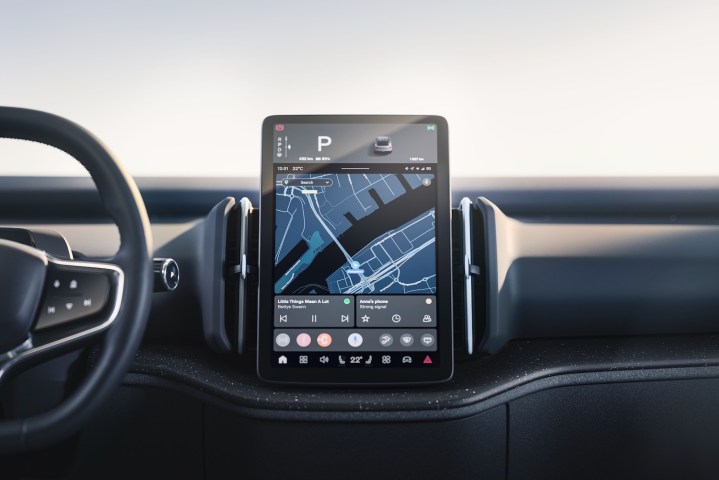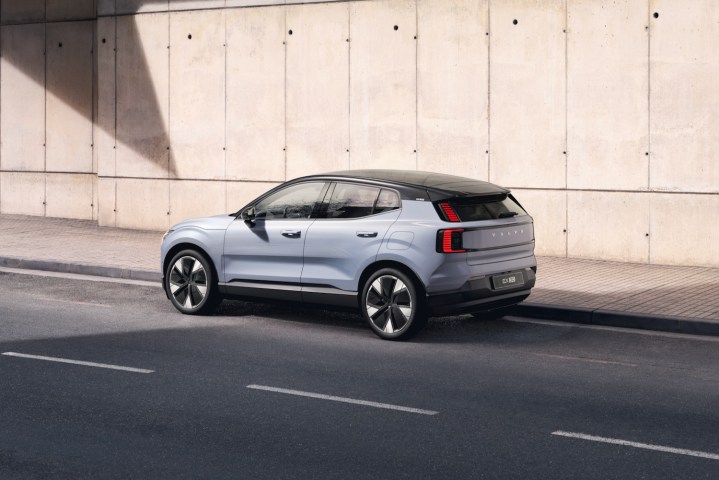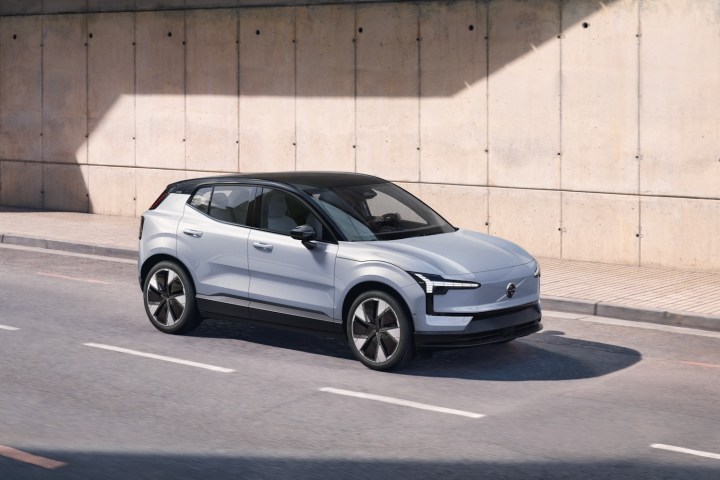
Electric cars aren’t just an opportunity for automakers to be friendlier to the planet. They’re an opportunity to try something new. That’s what Volvo is doing with its new EX30 crossover SUV.
The EX30 essentially represents a third stage of evolution for Volvo’s EVs. The Swedish automaker started with the XC40 Recharge and C40 Recharge, two EVs based on an existing internal-combustion architecture. It then showed the EX90, which was designed from the ground up as an EV, but in the image of the gasoline-powered Volvo XC90. Now, we get to see what an EV can look like with all the gasoline baggage shed.
Scheduled to reach U.S. dealerships in summer 2024 as a 2025 model, the EX30 is the smallest Volvo — and the cheapest. While it doesn’t qualify for a federal EV tax credit (unless Volvo chooses to exploit a leasing loophole), the EX30’s starting price of $36,145 is impressive for any EV right now, let alone one from a high-end brand like Volvo.
Smaller is better
Volvo’s history with small cars is full of wacky experiments like the 480 and C30, but not much success. Volvo finally hit on a winning formula with the XC40, but by introducing the smaller EX30 (it’s about eight inches shorter than the XC40), the automaker is throwing that away and entering unfamiliar territory.
Prioritizing a small car is also an interesting play for a premium brand. While Mercedes-Benz has its EQB and European-market EQA, the German automaker is putting more effort into high-end models. BMW has indicated it will offer affordable EVs at some point, but right now it’s filling out its lineup what electric versions of its traditional luxury models, like the 5 Series and 7 Series. Yet, a more affordable model made business sense to Volvo.
“You see a general trend of downsizing in society,” Björn Annwall, chief commercial officer and deputy CEO of Volvo Cars, told Digital Trends. Annwall said that trend already includes internal-combustion cars, noting higher-than-expected demand for Volvo’s XC40. A small EV makes even more sense, he said, because he expects customers to use a vehicle of this size as their second car — making range anxiety less of an issue.

This unorthodox strategy should be beneficial to customers, who will have a new sub-$40,000 EV to consider at a time when affordable EVs are all too rare. But Volvo claims it will also be beneficial for the planet. Because in addition to being Volvo’s smallest model, the EX30is aimed at having the smallest carbon footprint of any vehicle wearing the automaker’s Iron Mark logo.
EVs have zero “tailpipe” emissions, but that doesn’t count emissions generated by building them. Volvo aims to tackle this by using less steel and aluminum — another benefit of a smaller car — as well as more recycled or sustainable content, and by working with parts suppliers to increase renewable energy use in their manufacturing operations. The EX30 itself will be assembled in a factory powered by “high levels of climate-neutral energy, including 100% climate-neutral electricity,” according to Volvo. All this adds up to an estimated 25% reduction in life cycle carbon emissions from the current XC40 Recharge and C40 Recharge EVs.
Refined design
The EX30 moves Volvo’s styling forward. The scrunched-up shape is reminiscent of the XC40, and makes the EX30 seem like it’s trying to act tough despite its small size. At the back, broader rear fenders mean Volvo’s signature vertical taillights have been divided into two sections, giving the EX30 a distinctive, if unusual, look from behind.
At the front, the EX30 adopts the pixelated take on Volvo’s “Thor’s Hammer” LED headlights previously seen on its bigger sibling, the EX90. But the traditional grille shape has been largely erased, making it clearer that the EX30 is an EV. Big, rounded wheel arches contrast the straight body sides, giving the sheet metal some nice definition and ensuring the EX30 isn’t a shapeless blob.
For buyers who want their SUV to look as rugged as possible, an EX30 Cross Country variant will follow the standard version to showrooms in 2024. It gets a similar treatment to previous Volvo Cross Country models, including bigger wheels, an elevated ride height, and additional black exterior cladding — the automotive equivalent of wearing hiking boots to Starbucks.
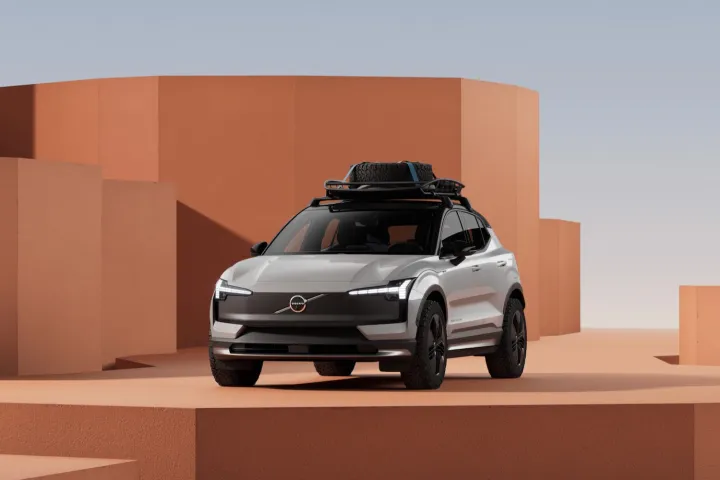
Like the exterior, the interior goes a little bit further down the path started by previous Volvo models. Minimalism has been a Volvo motif for some time, but the EX30 takes a step further by discarding the instrument cluster entirely, like a Tesla Model 3. There isn’t much besides a steering wheel and large vertical touchscreen. The stark interior trim is made from recycled materials, including denim from discarded jeans.
Volvo also moved the glovebox and window controls to the center console, while most of the audio system’s speakers take up residence in a soundbar on the dashboard. It’s all in the name of reducing material use and keeping costs down. Annwall, the Volvo chief commercial officer, believes this simplistic layout will win over customers, calling large numbers of screens “gimmicky.” But customers used to traditional cockpit layouts will have to relearn a lot.
Hot rod Volvo
For the U.S., the EX30 base model will be the Single Motor Extended Range, good for an estimated 275 miles per charge from a 69-kilowatt-hour battery pack with 64 kWh of usable capacity that uses nickel manganese cobalt (NMC) chemistry. A second battery option using lithium-iron-phosphate (LiFePO4) chemistry will be available in other markets. The single motor sends 268 horsepower and 253 pound-feet of torque to the rear wheels, enabling a Volvo-estimated zero-to-60-mph time of 5.1 seconds.
Alternatively, a Twin Motor Performance version gets the same battery pack and adds a second motor driving the front axle for all-wheel drive. Output from the two motors is 422 hp and 400 lb.-ft. of torque. Estimated range drops to 265 miles, but the zero-to-60-mph time also shrinks to an estimated 3.4 seconds — making this the quickest-accelerating Volvo production car ever. It also matches the factory-estimated zero-to-60 mph time of the six-figure Lucid Air Touring.
Charging performance is just as important in the real world, and here the specs paint a picture of mere adequacy. Volvo says the Twin Motor Performance model can DC fast charge at up to 153 kilowatts, allowing for a 10% to 80% charge in “a little over 26.5 minutes.” That’s the bare minimum for acceptability in today’s EV market, and it will be downright disappointing if the EX30 can’t hit that power rate and charge time in regular use.
No skimping on safety tech
Volvo built its reputation on safety, and while the automaker is light on details right now, it promises the EX30 will have a similar level of safety tech to its more expensive models. Highlights will include a feature designed to prevent drivers from opening the door into the path of an approaching cyclist (using sensors in the rear bumper to detect approaching two-wheeled traffic) and a new park-assist system that can maneuver the EX30 into parallel, perpendicular, and diagonal spaces.
Cost-cutting didn’t extend to infotainment tech. The EX30 runs a Google built-in infotainment system similar to other Volvo models, with the same chip as the larger and fancier EX90. While the user experience is Google-heavy, wireless Apple CarPlay will also be available. So will digital key functionality, allowing drivers to use a smartphone instead of a key fob, and over-the-air update capability.
A small car that’s a big deal
The EX30 counters a troubling trend in EVs that’s seen the pricing of models from mainstream brands creep up into luxury territory. Despite its reputation as a value brand, Hyundai feels comfortable starting its Ioniq 6 at $42,715 while letting pricing rise to nearly $60,000 for a range-topping version. The 2023 Kia EV6 starts at $43,925, but the cheapest version is only available on a limited basis, and only has 232 miles of range. Volvo, on the other hand, plans to sell a lot of EX30s.
“This will be one of our top-volume models in the U.S.,” Michael Cottone, president of Volvo Car USA and Canada, said in a roundtable interview, adding that Volvo intends to sell the EX30 in all 50 states. And while accountants are likely expecting higher-priced variants to pad the bottom line, many of the things that make the EX30 affordable are baked right in, from the smaller quantities of materials used to build it, to the simplified interior, to the basic architecture shared with multiple brands from Volvo parent Geely.
The EX30’s base price is a breath of fresh air. Volvo doesn’t have to make an affordable EV. It’s well established as a luxury brand and U.S. car shoppers are more than willing to pay a premium for it’s vehicles. And any automaker can point to things like high battery prices and the cost of retooling for EVs to justify higher prices. So it’s truly remarkable that, while mainstream brands deprioritize affordability, it’s Volvo that’s coming to the rescue.
